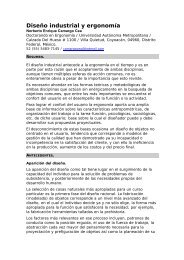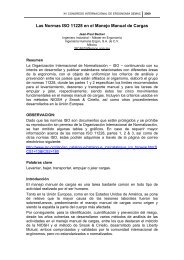ERGONOMÍA OCUPACIONAL - SOCIEDAD DE ERGONOMISTAS ...
ERGONOMÍA OCUPACIONAL - SOCIEDAD DE ERGONOMISTAS ...
ERGONOMÍA OCUPACIONAL - SOCIEDAD DE ERGONOMISTAS ...
You also want an ePaper? Increase the reach of your titles
YUMPU automatically turns print PDFs into web optimized ePapers that Google loves.
Ergonomía Ocupacional. Investigaciones y Aplicaciones. Vol 3 2010<br />
registros mencionados anteriormente se realizaban cada diez minutos. Resultados: Los<br />
resultados obtenidos fueron los siguientes: en el operador 1, se encontró correlación en los ciclos<br />
por minuto contra temperatura y contra fuerza; además el máximo en: la temperatura fue<br />
35.93°C, la fuerza 82 kg y los ciclos por minuto fue de 138 movimientos y el mínimo en: la<br />
temperatura fue 28.11°C, la fuerza 36 kg y los ciclos por minuto fue de 93 movimientos; en el<br />
operador 2 la correlación que se manifestó fue la de ciclos por minuto contra temperatura;<br />
además el máximo en: la temperatura fue 34.87°C, la fuerza 63 kg y los ciclos por minuto fue de<br />
140 movimientos; y el mínimo en: la temperatura fue 29.38°C, la fuerza 32 kg y los ciclos por<br />
minuto fue de 100 movimientos. Conclusiones: En base a este estudio se concluye que: existe<br />
correlación entre temperatura contra los ciclos por minuto y entre la fuerza contra ciclos por<br />
minuto; asimismo que no existe correlación entre temperatura y fuerza.<br />
Palabras clave: Temperatura, Fuerza, Ciclos por minuto.<br />
ABSTRACT. The need to protect workers against the causes of occupational diseases and accidents<br />
is a no doubt question. Hence the interest to analyze the behavior with variables in temperature in<br />
the area of the wrist, strength and cycles per minute, that to perform horizontal repetitive<br />
movements of the wrist, which are commonly found in workplaces. Objective: The objective was to<br />
correlate the variables of temperature, strength and number of movements per minute when working<br />
with horizontal repetitive movement of the right hand wrist area. Delimitation of the problem: It was<br />
simulated a working day of 8 hours with 2 operators (man and women) exerting horizontal<br />
movements, on the installations of the Faculty of Engineering Ensenada of the Autonomous<br />
University of Baja California. Methodology: It was simulated a working day with two operators<br />
exerting horizontal movements, and for this making the temperature recorder in the area of the<br />
right hand wrist (sensorial thermograph Sköll), the strength of the operator (dynamometer wrist-<br />
twisting Baseline) and cycles per minute, the three mentioned records were made every ten<br />
minutes. Results: The obtained results were: in the operator 1 ,there was a correlation in cycles<br />
per minute against temperature and against strength, besides the maximum in: temperature was<br />
35.93°C, strength was 82 kg and cycles per minute was 138 movements and the minimum in:<br />
temperature was 28.11°C, strength was 36 kg and cycles per minute was 93 movements; in the<br />
operator 2: there was a correlation in cycles per minute, besides the maximum in: temperature<br />
Sociedad de Ergonomistas de México, A.C. 99




